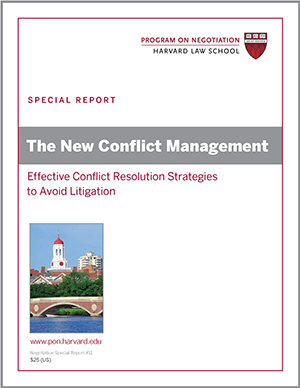
How can you engage in crisis negotiations with someone who doesn’t trust you? Consider bringing in individuals the other party does trust to play the role of mediator in the dispute, as the FBI did to promote a peaceful end to a standoff with occupiers of the Malheur National Wildlife Refuge in February 2016.
Strategic Patience
On January 2, 2016, armed protestors took over the wildlife refuge in Oregon in objection to the U.S. government’s ownership of the land. They demanded that the government cede the land to locals and release two Oregon ranchers recently reimprisoned for burning federal property.
At first, federal authorities allowed the protestors to come and go from the refuge and to speak to the media. Since previous violent confrontations with antigovernment protestors, such as the Ruby Ridge standoff, the FBI had a policy of “strategic patience” in such situations—giving protestors time to cool off in the hope they would surrender voluntarily. The authorities were also creating opportunities for the occupiers to make press statements that could be used to arrest them, reports National Public Radio.
A Brief Negotiation
On January 21, the occupiers’ leader, Ammon Bundy, traveled to the FBI’s nearby operations base and asked to speak to a crisis negotiator identified only as Chris, who had been leaving him voice-mail messages. Told that Chris wasn’t at the base, Bundy called him and allowed others present to listen in.
Chris listened to Bundy’s complaints and, without making any commitments, asked about how they could end the standoff. “The conversation sounded in some ways like acquaintances catching up,” according to the Oregonian. The two men agreed to continue their crisis negotiations the next day, but Bundy changed his mind.
Violence, Then Mediation
On January 26, FBI agents and Oregon state police officers stopped Bundy and other occupiers on a highway outside the refuge. When one of them, LaVoy Finicum, allegedly reached into his jacket pocket for a gun, two officers shot him dead. (The FBI agents were later accused of failing to disclose that they had also discharged their weapons.) Bundy and other occupiers were arrested. In court the following day, Bundy asked the remaining occupiers to “stand down” and leave the refuge. All but four acquiesced.
In crisis negotiations with the FBI, the remaining occupiers demanded to be allowed to leave the refuge without being arrested. A breakthrough came when the FBI enlisted Christian evangelist Franklin Graham to try to mediate a resolution by phone. For more than a week, Graham worked to bring the occupiers “to a point where they were ready to leave of their own volition,” according to National Public Radio.
The FBI Moves In
On February 10, FBI agents in armored vehicles ordered the occupiers to surrender. On YouTube, the four occupiers accused the FBI of betraying them and rejected the demands.
FBI special agent Greg Bretzing released a statement saying the bureau had “reached a point where it became necessary to take action” to ensure the safety of the occupiers, law enforcement, and local citizens.”
The four holdouts said they would surrender the following morning but first wanted to meet in person with Nevada state legislator Michele Fiore and with Graham.
A Reassuring Voice
That afternoon, Fiore, a vocal supporter of the occupation’s leaders, spoke with the remaining occupiers, assisted by one of Bundy’s lawyers, Mike Arnold. Soon Fiore and Arnold were racing by truck to the refuge. “We need to stay calm,” Fiore told the occupiers. “I need you to be alive to make a change.”
An FBI agent called Arnold to say that Fiore was doing well and should continue to try to get the occupiers to calm down. Fiore repeatedly paused the crisis negotiations to engage the occupiers in prayer. Eventually, she convinced the four that the FBI would not move on them overnight, and they again agreed to surrender in the morning.
The Final Hours
Early the next day, the FBI brought Fiore and Graham to the outskirts of the refuge. “A dead man can’t talk, a dead man can’t write,” Fiore reminded the holdouts via phone.
Three men emerged with their hands raised; the fourth soon surrendered as well.
“I’m really glad they’re safe,” Fiore told the Oregonian. “And I also have to give kudos to the FBI agents out there. No one got hurt.”
Lessons from Tense Crisis Negotiations
Those engaged in crisis negotiations with a distrustful party may find the following lessons from the Oregon standoff helpful:
- Exercise strategic patience. Resist the urge to respond immediately to provocative acts. A slow-paced approach to conflict resolution can help de-escalate tensions while strengthening parties’ motivations to end the dispute.
- When possible, meet in person. Bundy cut off talks with the FBI after it failed to provide him with a crisis negotiator he could meet with face-to-face. In-person meetings humanize negotiators and foster rapport.
- Enlist trusted mediators. Thanks to their conservative credentials and sympathy to the occupiers’ cause, Graham and Fiore played crucial roles in the crisis negotiations. Look for people both parties trust to engage in mediation.
What other advice do you have for successfully managing crisis negotiations?





